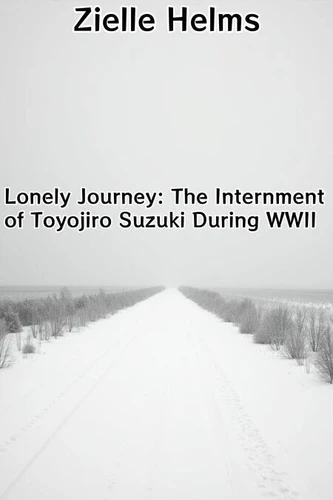Lonely Journey: The Internment of Toyojiro Suzuki During WWII
Par :Formats :
Disponible dans votre compte client Decitre ou Furet du Nord dès validation de votre commande. Le format ePub est :
- Compatible avec une lecture sur My Vivlio (smartphone, tablette, ordinateur)
- Compatible avec une lecture sur liseuses Vivlio
- Pour les liseuses autres que Vivlio, vous devez utiliser le logiciel Adobe Digital Edition. Non compatible avec la lecture sur les liseuses Kindle, Remarkable et Sony
 , qui est-ce ?
, qui est-ce ?Notre partenaire de plateforme de lecture numérique où vous retrouverez l'ensemble de vos ebooks gratuitement
Pour en savoir plus sur nos ebooks, consultez notre aide en ligne ici
- FormatePub
- ISBN8227210050
- EAN9798227210050
- Date de parution14/03/2025
- Protection num.pas de protection
- Infos supplémentairesepub
- ÉditeurBig Dog Books, LLC
Résumé
Comprehensive Summary of Toyojiro Suzuki's Internment DiaryI. Introduction: Context, Background, and the Road to InternmentToyojiro Suzuki's diary is an intimate, day-by-day record of a man caught in the turbulent currents of history. Born in Japan in 1903, Suzuki immigrated to the United States in 1920 to work in the fishing industry alongside his father. His life in America-marked by hard work, family ties, and cultural challenges-was dramatically upended by the events of World War II.
Although he had obtained a Social Security number and was married to a U. S. citizen, he never became a naturalized citizen. This technical status would later contribute to his vulnerability. The diary opens at a time of profound national crisis. Just eight weeks after Japan's surprise attack on Pearl Harbor on December 7, 1941, suspicion and xenophobia swept across the United States, especially against Japanese immigrants.
Suzuki's narrative begins on Terminal Island in Los Angeles-a hub for Japanese fishermen and a community that had long experienced the ambivalence of being valued for labor yet marginalized as neighbors and citizens. With his close-knit community of fishermen, Suzuki was about to face an ordeal that would test not only his physical endurance but also his mental and emotional fortitude.
Although he had obtained a Social Security number and was married to a U. S. citizen, he never became a naturalized citizen. This technical status would later contribute to his vulnerability. The diary opens at a time of profound national crisis. Just eight weeks after Japan's surprise attack on Pearl Harbor on December 7, 1941, suspicion and xenophobia swept across the United States, especially against Japanese immigrants.
Suzuki's narrative begins on Terminal Island in Los Angeles-a hub for Japanese fishermen and a community that had long experienced the ambivalence of being valued for labor yet marginalized as neighbors and citizens. With his close-knit community of fishermen, Suzuki was about to face an ordeal that would test not only his physical endurance but also his mental and emotional fortitude.
Comprehensive Summary of Toyojiro Suzuki's Internment DiaryI. Introduction: Context, Background, and the Road to InternmentToyojiro Suzuki's diary is an intimate, day-by-day record of a man caught in the turbulent currents of history. Born in Japan in 1903, Suzuki immigrated to the United States in 1920 to work in the fishing industry alongside his father. His life in America-marked by hard work, family ties, and cultural challenges-was dramatically upended by the events of World War II.
Although he had obtained a Social Security number and was married to a U. S. citizen, he never became a naturalized citizen. This technical status would later contribute to his vulnerability. The diary opens at a time of profound national crisis. Just eight weeks after Japan's surprise attack on Pearl Harbor on December 7, 1941, suspicion and xenophobia swept across the United States, especially against Japanese immigrants.
Suzuki's narrative begins on Terminal Island in Los Angeles-a hub for Japanese fishermen and a community that had long experienced the ambivalence of being valued for labor yet marginalized as neighbors and citizens. With his close-knit community of fishermen, Suzuki was about to face an ordeal that would test not only his physical endurance but also his mental and emotional fortitude.
Although he had obtained a Social Security number and was married to a U. S. citizen, he never became a naturalized citizen. This technical status would later contribute to his vulnerability. The diary opens at a time of profound national crisis. Just eight weeks after Japan's surprise attack on Pearl Harbor on December 7, 1941, suspicion and xenophobia swept across the United States, especially against Japanese immigrants.
Suzuki's narrative begins on Terminal Island in Los Angeles-a hub for Japanese fishermen and a community that had long experienced the ambivalence of being valued for labor yet marginalized as neighbors and citizens. With his close-knit community of fishermen, Suzuki was about to face an ordeal that would test not only his physical endurance but also his mental and emotional fortitude.





